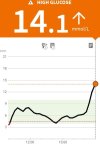DianeD
Well-Known Member
- Relationship to Diabetes
- Type 1
- Pronouns
- She/Her
Basel abasaglar 12 units in morning (working a treat)
Bolus Turapi no idea what ratio to do
Used to walk 7 miles a day now can't to 10mins without a hypo
Hate food. Don't know how to carb count properly and getting it wrong or the bolus wrong. 1:10 gives me spikes 1:8 gives me hypos 1:9 can go either way, then the roller coater starts. Feeling so ill all the time. How do I stop it?
Bolus Turapi no idea what ratio to do
Used to walk 7 miles a day now can't to 10mins without a hypo
Hate food. Don't know how to carb count properly and getting it wrong or the bolus wrong. 1:10 gives me spikes 1:8 gives me hypos 1:9 can go either way, then the roller coater starts. Feeling so ill all the time. How do I stop it?

